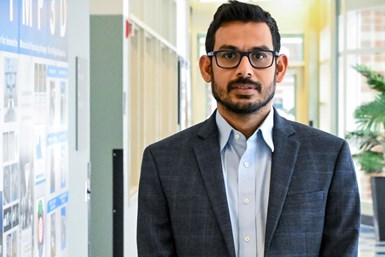Guha Manogharan Named Co-Director of Penn State’s Additive Manufacturing Center
Penn State’s Center for Innovative Materials Processing through Direct Digital Deposition is an interdisciplinary research center that works to advance additive manufacturing and materials research.
Guha Manogharan, associate professor of mechanical engineering at Penn State, was named co-director of the Center for Innovative Materials Processing through Direct Digital Deposition (CIMP-3D). Manogharan replaces Tim Simpson, the Paul Morrow Professor of Engineering Design and Manufacturing, who has served in the position since the center’s founding in 2012.
“I am thankful for the opportunity to advance CIMP-3D’s prominent role in the additive manufacturing community, having personally benefited from its world-class resources and institutional knowledge as a researcher,” Manogharan says. “As co-director, I look forward to developing new capabilities for CIMP-3D in additive manufacturing research, development and education. I will also focus on creating opportunities for students and researchers from Penn State’s commonwealth campuses to leverage CIMP-3D facilities and expertise.”
Located at Innovation Park, CIMP-3D is an interdisciplinary research center that works to advance additive manufacturing (AM) and materials research. The center offers industry-quality production capabilities of polymer, metal and ceramic structures, including multimaterial additive and large-scale robotic arc and laser AM systems, as well as advanced process sensing and control.
The center provides technical assistance to industry, government and academic partners while engaging in workforce development, education and outreach activities. CIMP-3D is staffed by 20 full-time engineers and scientists from Penn State’s Applied Research Laboratory (ARL) that support the research activities of more than 45 faculty associates from five colleges across the university.
Manogharan will serve as co-director on behalf of the College of Engineering, joining Associate Research Professor Ted Reutzal, CIMP-3D director, from ARL, and Professor Allison Beese, CIMP-3D co-director, from the College of Earth and Mineral Sciences (EMS). Beese also serves as director of Penn State’s additive manufacturing and design graduate programs, and has an affiliation with the Department of Mechanical Engineering.
“Guha’s curiosity, relentless energy and passion for additive manufacturing will uphold the center’s legacy and jumpstart new innovations,” Reutzel says. “His drive to push the boundaries of additive manufacturing will ensure CIMP-3D remains a global leader in the discovery, development and deployment of additive manufacturing technology for years to come.”
Manogharan, who also has affiliations with industrial and manufacturing engineering, and nuclear engineering in the College of Engineering and materials science and engineering in EMS, joined Penn State in 2016. He completed his graduate studies at North Carolina State University, earning a master’s degree and a doctorate in industrial and systems engineering. He directs the Systems for Hybrid-Additive Process Engineering (SHAPE) Lab at Penn State.
“Dr. Manogharan is a recognized expert in additive manufacturing,” says Mary Frecker, Riess Chair of Engineering, professor and head of the Department of Mechanical Engineering. “His leadership will advance CIMP-3D’s prominence nationally, as well as foster collaboration among researchers at Penn State.”
Related Content
-
Postprocessing Steps and Costs for Metal 3D Printing
When your metal part is done 3D printing, you just pull it out of the machine and start using it, right? Not exactly.
-
3D Printing with Plastic Pellets – What You Need to Know
A few 3D printers today are capable of working directly with resin pellets for feedstock. That brings extreme flexibility in material options, but also requires greater knowledge of how to best process any given resin. Here’s how FGF machine maker JuggerBot 3D addresses both the printing technology and the process know-how.
-
How to Organize for Additive Production: AM Radio #42
Tim Simpson and Peter Zelinski discuss the next steps for succeeding with AM: After technical and process successes come the cultural, organizational and even costing considerations associated with this mode of manufacturing.












